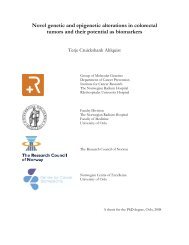Preface - Ous-research.no
Preface - Ous-research.no
Preface - Ous-research.no
Create successful ePaper yourself
Turn your PDF publications into a flip-book with our unique Google optimized e-Paper software.
Integrated Cardiovascular Function<br />
echocardiography can play an important role in this population.<br />
We have collaborated with Methodist DeBakey Heart<br />
and Vascular Center in Houston in a prospective multicenter<br />
study to examine the application of Doppler echocardiography<br />
for the hemodynamic assessment of patients with<br />
ADHF.<br />
4. Coronary artery occlusion: Although acute myocardial<br />
infarction is treated preferably by early percutaneous<br />
coronary intervention (PCI), there is limited access to this<br />
treatment, and a large fraction of patients receive intrave<strong>no</strong>us<br />
thrombolytics as primary treatment. These patients are<br />
referred for “rescue PCI” only when there is <strong>no</strong> reperfusion<br />
after thrombolytic treatment. The main problems with the<br />
latter strategy are that all myocardium at risk may have undergone<br />
necrosis and therefore PCI is unnecessary. Furthermore,<br />
we lack reliable methods to determine if reperfusion<br />
has been achieved by the thrombolytic. One of our main<br />
objectives is to develop better functional imaging in order<br />
to differentiate between viable and necrotic myocardium<br />
and to determine when reperfusion has been achieved.<br />
5. Narrow QRS: Cardiac resynchronisation therapy (CRT) has<br />
been documented to be a powerful treatment in patients<br />
with severe congestive heart failure and left bundle branch<br />
block (LBBB). Interestingly, there has also been demonstrated<br />
clinical effect of CRT in patients with narrow QRS.<br />
As more than two thirds of heart failure patients do <strong>no</strong>t<br />
have electrical conduction disturbances extending the<br />
indications for CRT into this patient group is going to have<br />
considerate implications.<br />
The mechanisms of possible effects of this treatment in<br />
heart failure patients with narrow QRS have <strong>no</strong>t been discovered<br />
properly. Two possible mechanisms have been suggested:<br />
CRT may correct electrical dyssynchrony <strong>no</strong>t seen on<br />
ECG or CRT induces changes the interventricular interaction.<br />
The change in ventricular interaction can be obtained by<br />
pacing in the left ventricular lateral wall. The left ventricle<br />
is then activated earlier than the right ventricle and a concomitant<br />
phase shift in the ventricular filling appears. This<br />
phase shift reduces the left ventricular external constraint.<br />
External constraint is determined by the pericardial pressure<br />
and the right ventricular pressure and constitutes the<br />
external resistance to left ventricular filling. The hemodynamically<br />
result of reduced external constraint is improvement<br />
of left ventricular filling and increase in cardiac output.<br />
6. Optimal timing of cardiac surgery for chronic valvular<br />
regurgitations has been a challenge for years. Development<br />
of systolic dysfunction precedes the onset of symptoms in<br />
more than one fourth of the patients with this condition.<br />
Traditional echo-cardiographic methods like preoperative<br />
left ventricular ejection fraction (LVEF) and cavity dimensions<br />
are the most important determinants of survival and left<br />
ventricular (LV) function after valve replacement for regurgitations.<br />
However, volume derived measures of LV function<br />
have important limitations in assessing myocardial contractile<br />
function where a series of compensatory mechanisms,<br />
including an increase in end-diastolic volume (EDV) and<br />
hypertrophy, can mask underlying changes in myocardial<br />
force development. Therefore, the purpose of these studies<br />
are to investigate whether global systolic strain measured<br />
by 2-dimensional speckle tracking echocardiography (2D-<br />
STE) could detect early onset of myocardial dysfunction in<br />
patients with chronic regurgitations and preserved LVEF.<br />
Collaborators<br />
Prof. Joao A.C. Lima, Johns Hopkins University, Baltimore,<br />
Maryland, USA<br />
Prof. Sherif Nagueh, Methodist DeBakey Heart and Vascular<br />
Center, Houston, Texas<br />
Prof. Jens-Uwe Voigt, Katholieke Universiteit Leuven, Belgium.<br />
Prof. Hans Torp, NTNU, Trondheim<br />
Prof. Håvard Attramadal, Rikshospitalet, Research group:<br />
Molecular Cardiology<br />
Consultant Harald Brunvand, MD, PhD, Sørlandet hospital,<br />
Arendal.<br />
An experimental dog model is used to explore these electromechanical<br />
and hemodynamic consequences of CRT. The<br />
study is ongoing, but some preliminary results have already<br />
been presented at international congresses.<br />
21
















